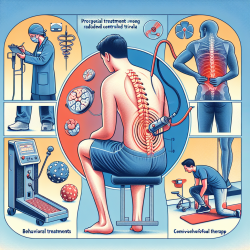Exploring Combined Treatments for Chronic Low Back Pain
Chronic low back pain (CLBP) is a pervasive issue affecting many individuals, often leading to significant disability and increased healthcare costs. While individual treatments for CLBP tend to offer limited relief, combining different treatment modalities may enhance outcomes. A recent pilot feasibility randomized controlled trial (RCT) explored the potential of combining procedural and behavioral treatments for CLBP, providing valuable insights for practitioners seeking to enhance their therapeutic strategies.
The Study: A Pilot Feasibility RCT
The study utilized a 2×2 factorial RCT design to assess the feasibility and effectiveness of combining lumbar radiofrequency ablation (LRFA) with Activity Tracker-Informed Video-Enabled Cognitive Behavioral Therapy (AcTIVE-CBT) for CLBP. Participants were randomized to receive either LRFA or a simulated control procedure, and either AcTIVE-CBT or an educational control treatment. The primary outcome was measured using the Roland-Morris Disability Questionnaire (RMDQ) at three months post-randomization.
Key Findings
- The study demonstrated feasibility with an enrollment proportion of 62% and a randomization proportion of 81%, surpassing the feasibility goals.
- All randomized participants completed the primary outcome assessment, indicating robust participant retention.
- While the effect of LRFA alone was not statistically significant, it showed a moderate beneficial effect compared to control.
- AcTIVE-CBT demonstrated a significant, large-magnitude beneficial effect on back-related disability.
- The combination of LRFA and AcTIVE-CBT showed a large beneficial effect, though not statistically significant, suggesting potential additive benefits.
Implications for Practitioners
For practitioners, these findings highlight the potential benefits of integrating procedural and behavioral treatments for CLBP. The significant effect of AcTIVE-CBT suggests that incorporating cognitive-behavioral strategies, especially those delivered via telehealth, can substantially improve patient outcomes. Practitioners are encouraged to consider these findings when developing treatment plans for patients with CLBP.
Encouraging Further Research
This pilot study opens avenues for further research into combined treatment modalities for CLBP. Larger-scale RCTs could provide more definitive evidence of the benefits and inform best practices for integrating procedural and behavioral therapies. Practitioners are encouraged to stay informed about ongoing research in this area and consider participating in studies to advance the understanding and treatment of CLBP.
To read the original research paper, please follow this link: Combining Procedural and Behavioral Treatments for Chronic Low Back Pain: A Pilot Feasibility Randomized Controlled Trial.










